#spsf
Explore tagged Tumblr posts
Text
A Lot Going on Here

t's a cloudy April 17, 1971, a busy day on Tehachapi. SP 3207 is leading the northbound SAN JOAQUIN DAYLIGHT around the iconic loop at Walong, California. The Santa Fe units are off a southbound train left at Woodford, the next siding north. The AT&SF locomotives helped push a stalled northbound SP freight into the Walong siding to clear up for the DAYLIGHT. (You can spot the top of the SP caboose behind the four units.) As soon as the DAYLIGHT clears, the Santa Fe units will follow and couple to their train at Woodford.

It was a cloudy day, but because of all the action, it was one of my best trips to that popular piece of mountain railroading
(Joe McMillan on Flickr)
34 notes
·
View notes
Text
Southern Pacific Railroad 1991 Near Bakersfield
youtube
Came for the SPsf tunnelmotor at 80mph on the empty intermodals -- stayed for the Foster Farms Chicken ALCO



10 notes
·
View notes
Video

As close as we get to what Reagan took from us. SPSF: never forget.
Nearing Mojave. by John Whiteley Via Flickr: DRGW SD40T-2 No. 5347 leads a n eastbound coal train round Warren Curve. 5 April 1995.
50 notes
·
View notes
Video
Tale of an F45 por James Belmont Por Flickr: Doug Harrop Photography • April 8, 1977 A Santa Fe Railway F45 leads a five pack of six axle EMDs through 259 ft. Tunnel 17 in the Tehachapi Mountains west of Cable, California. Santa Fe 5910 has quite an interesting story to tell. It began its service life as ATSF 1910, built by EMD in June 1968. It would later be renumbered ATSF 5910, later 5960, and by 1985 it received a fresh coat of SPSF livery, for a proposed merger that never happened. After retirement, 5960 was sold to Morrison Knudsen who renumbered it MKCX 5531, joining the lease fleet. By May 1995 it was leased to the Utah Railway, becoming UTAH 9013 and assigned to haul coal across Soldier Summit. After the lease ran out in 2001, it was shipped to Metro East Industries in East St. Louis, Illinois and was placed in storage, where it remained until at least 2007. By 2009, it arrived in Essex, Montana. The prime mover had been removed, and the body and cab interior became a luxury hotel. It was renumbered to GN 441 and repainted in Great Northern's attractive "Sky Blue" livery where it stands today.
13 notes
·
View notes
Text

Argentine Yard was a focal point for Santa Fe power on the eastern portion of their railroad. Evidence of the ill-fated SPSF merger was on display this day along with regular power and some Conrail intruders. June 28, 1986
#atsf#santa fe#cr#conrail#1986#trains#freight train#history#argentine yard#argentine#kansas city#kansas
3 notes
·
View notes
Text
Free National Pool Operator Course

Enhance Your Career with a Free National Pool Operator Course – Limited Time Offer
Free National Pool Operator Course for ALA Lifeguard Recertification Candidates
FREE OFFER ENDS JUNE 1, 2025

Lifeguards who obtain a pool operator certification typically earn several dollars more per hour than those with only a lifeguard certification. Additionally, this credential is often required for pool managers, making it an essential asset for career advancement.
To support the professional growth of our members, the American Lifeguard Association (ALA) is pleased to offer a complimentary SPSA National Pool Operator Course exclusively to newly registered lifeguard recertification candidates. This $250 value is available completely free to those who enroll in the ALA Lifeguard Recertification Course, which is offered at the affordable price of just $185.
Our flexible recertification program is designed to accommodate lifeguards certified by ALA or any other nationally recognized certifying organization. With our program, you can renew your certification for an additional two years, regardless of where you originally trained or if your previous certification has expired. Our courses are available year-round and can be completed at your convenience, anytime and anywhere.
This is an excellent opportunity to expand your qualifications at no additional cost while ensuring you meet industry standards for both lifeguarding and pool management.
A National Initiative to Improve Public Pool Safety
As part of our commitment to enhancing public swimming pool safety nationwide, the ALA has received a national grant to support this initiative. Through this funding, the SPSA National Pool Operator Course will be available free of charge exclusively to eligible ALA lifeguard recertification candidates who register between now and June 1, 2025.
This initiative reflects our dedication to bridging gaps in public health funding, ensuring that public swimming pools continue to operate safely and efficiently. The SPSA National Pool Operator Course, typically offered at a competitive rate, provides essential training in pool safety operations, water quality management, and compliance with health and safety regulations. By offering this course at no cost, ALA aims to equip lifeguards and aquatic professionals with the knowledge and skills necessary to uphold the highest safety standards in aquatic environments.
To learn more about the course, please visit our course page SPSA National Pool Operator Course.
Offer valid for newly registered ALA lifeguard recertification candidates only. Free enrollment available for those who register between now and June 1, 2025.
How to Register
Lifeguard recertification candidates interested in the free SPSA National Pool Operator Course should email us at [email protected] on the same day they register and pay for their lifeguard recertification course with us, including the following details.
First and last name (as it appears on your ALA Lifeguard certification)
Date of birth
Once we verify your registration, we will provide free access to this essential training program. This course equips you with the knowledge and skills necessary to ensure the safe operation of public swimming pools.
Course Overview
This 8-module online course is built on a state-of-the-art educational platform and includes a detailed 231 page SPSF PO Manual, from the Swimming Pool and Spa Foundation, a 501(c)(3) nonprofit association. Each module provides comprehensive training on key aspects of pool operations, with mandatory quizzes to ensure mastery before advancing.
Estimated Completion Time: Approximately 16 hours, including quizzes and the final exam.
Final Exam: A 3-hour open-book, 50-question multiple-choice exam proctored by an employer, teacher, or parent/legal guardian.
Key Features of the Program
Newly Released for 2025: Incorporates the latest safety standards and operational guidelines.
Professionally Produced: Developed using advanced educational tools to ensure effective learning.
CDC-Aligned Training: Follows CDC recommendations regarding covering all important topics to enhance pool safety and prevent public health risks.
Comprehensive Curriculum: Covers water disinfection, mechanical systems, safety protocols, and more.
Why This Matters
With recent concerns about possible CDC budget cuts affecting programs like the Model Aquatic Health Code (MAHC), the ALA recognizes the importance of stepping up to provide resources that safeguard public health. Proper pool operation is a cornerstone of water safety, reducing the risks of waterborne illnesses, injuries, and accidents. This proactive measure ensures that even if federal support wanes, communities across the nation will continue to have access to the expertise required to operate safe and compliant aquatic facilities.
How This Initiative Benefits Everyone
Supports ALA Lifeguard Members: Providing free access to the SPSA National Pool Operator Course helps ensure lifeguards stay informed on proper swimming pool operation.
Promotes Public Safety: Well-trained operators and lifeguards help reduce the risks associated with waterborne illnesses, improper chemical handling, and other hazards.
Fills the Funding Gap: This initiative ensures continuity in safety standards, even as public health programs face potential cuts.
Encourages Community Confidence: Offering free training demonstrates a commitment to public health and safety, fostering trust in aquatic facilities.
By empowering lifeguards with this critical training, we aim to help ensure the safe and enjoyable use of aquatic facilities.
#lifeguard training#lifeguard class#lifeguards#lifeguard course#swimming#lifeguard shortage#health & fitness#swimming pool#swimming training#home & lifestyle
1 note
·
View note
Text
Wish black BNSF 4449 2001 had the big ATSF tender lettering, "4449" back there. Always thought this one was like going through a fetish/kink/leather phase: super excited to try it once and it was fun and all but really it's just too much work and never really felt the need to back, especially when the Daylight is sooooo nice don't really want to change you know?



#4449#bnsf#hmmm#spsf#did 4449 ever get dressed up in SPSF livery? that would've been a treat! melt pharoh's heart and let his people go#not sure how i feel about reagan now
39 notes
·
View notes
Text

Have you HOPPED to it and pre-registered for BayCon 2024: Pure Imagination yet?? Only a few days left to score yourself a full weekend badge for $115 !! Badge price will go up to $130 beginning April 2nd! The full weekend badge is good for all four days, and gives you access to most events, panels, and activities! (This year even more: e-gaming, film room, boffers,etc.)
We also still have CHARTER memberships to BayCon's parent non-profit, the Society for the Promotion of Speculative Fiction (spSF), which are still only $150 and include a free badge for next year! These go up to $180 on November 1st! Don't wait! Purchase a CHARTER Membership today!
BADGE PRICES VIP Badges: $385 Full Weekend Pass: $115 (until April 2nd) Teen & Youth Passes: $30
Already a charter member and want to purchase a VIP Badge? Upgrade options are available! See our registration page at baycon.org/registration.
#BayCon#BayCon2024#convention#fandom#speculative fiction#Bay Area fandom#Bay Area#fan convention#registration#membership
1 note
·
View note
Video
Southern Pacific SDP45s 3207 and 3201 eastbound Super Bowl Train to New Orleans at Sargent, CA on the Coast Line on January 20, 1986 -- 2 Photos by Marty Bernard Via Flickr: A Roger Puta Photograph
28 notes
·
View notes
Text
instagram


16 notes
·
View notes
Text
Southern Pacific Railroad GP9's
youtube
Just SP GP's on point; FRED on rear of this overpowered fast freight with vintage railfanning pacing action. Bonus ballast train barging through with a raft of SPMW side-dumps surprise sighting of the section's ballast regulator and tamping machine.
#sp#Kodachrome#shouldn't paint so fast#spsf#gp9#tunnelmotor#southern pacific#Marysville#trains#railfanning#youtube#vhs#camcorder
3 notes
·
View notes
Video
Santa Fe 5201 meets 5804 by John Shine Via Flickr: Holding at the signal at the East end of double track and waiting to enter Santa Ana Canyon, SD45-2 5804 in SPSF paint holds for the Westbound Harbor train led by SD40-2 5201 in December of 1987. This location is now triple track and has many large warehouses and homes in the area ruining what was once a nice rural landscape.
20 notes
·
View notes
Note
Sad that the spsf rail merger never went through
https://youtu.be/I9bPJGJh-BU

The livery was so pleasing
no literally
7 notes
·
View notes
Text
Very interesting and a topic that deserves more thought!!!
Especially (in my mind) what differences and changes to the regulatory environment would've ensured better outcomes for all stakeholders. A railroad prints money, being orders of magnitude more efficient than trucking, more direct than shipping, and yet ...
Reagan personally killing the SPSF merger, comes to mind.
Some of the absurd laws we have mandating the railroads religiously continue some out-dated practices, blablablahFRA, how trains are controlled and dispatched and crewed, and how grade crossings are done (poorly)—but also the tax structures and appreciating land values rising expenses and off shoring of the industry ecosystem that railroads are largely part of ... On and on!
What-If: American Railroads — Maps
I deeply apologize for not coming back to this alternate railroad history topic in over a year, I’ve had a lot of other things to do and i merely scratched the surface of this railroad history topic. and therefore, I’ve thought long and hard about this whole thing.
Aside from that apology, i thought to myself since I have Procrate, why not make maps of the 20 American railroads in my alternate history about said American railroads? And that’s what I did. Each map below shows the 20 railroads after they absorbed the smaller railroads as well as some of them expanding their networks in the 1980s wherever possible.

New York Central — this map shows the New York Central after the road to the future absorbed Boston & Maine, New Haven , Delaware & Hudson, Rutland Railroad, Bangor & Aroostook, Central Vermont And Maine Central railroads.
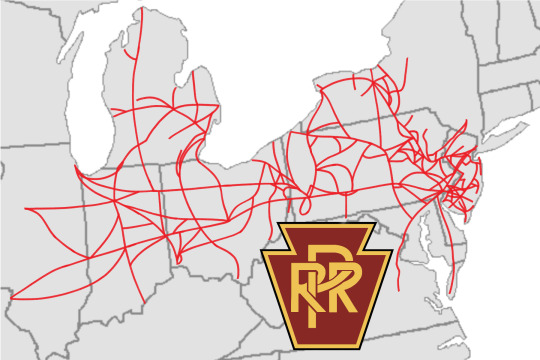
2. Pennsylvania Railroad — This map shows the size of the Pennsylvania Railroad after it absorbed Lehigh New England, Reading Lines/Railroad, Richmond, Fredericksburg and Potomac, Lehigh Valley, Lehigh and Hudson River, Central Railroad of New Jersey, Grand Trunk Western and Pennsylvania-Reading Seashore Lines railroads.

3. Chesapeake & Ohio — This map shows the Chesapeake & Ohio after it acquired the Erie Railroad, Lackawanna Railroad and New York, Ontario & Western Railway, plus the northern section of the Louisville & Nashville Railroad throughout the 50s and 60s, as well as expanding its network in the 80s.
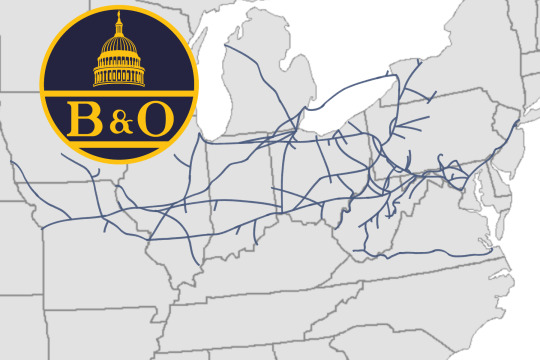
4. Baltimore & Ohio — This map shows how big the Baltimore & Ohio got after America’s first railroad absorbed Pittsburgh and Lake Erie, Western Maryland, Wabash, Ann Arbor, Virginian railroads.
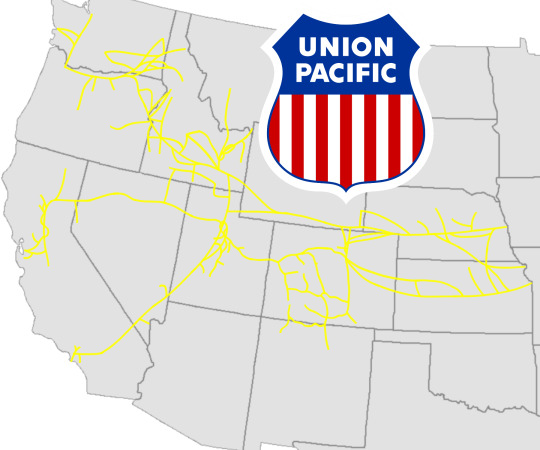
5. Union Pacific — Here, this is how big Union Pacific got after absorbing the Western Pacific and Rio Grande railroads, as well as adding more mainlines in the eighties.
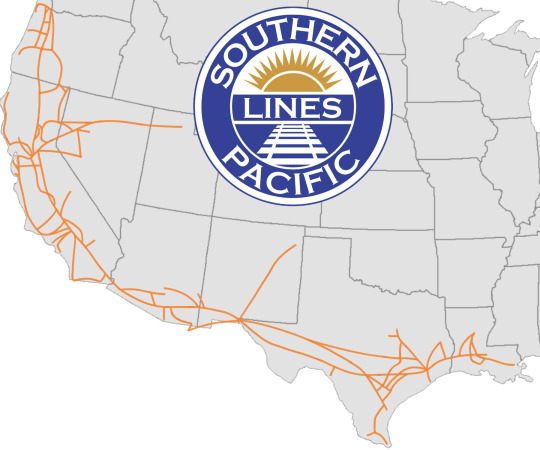
6. Southern Pacific — This map shows the Southern Pacific after adding more mainlines to its network in the eighties.
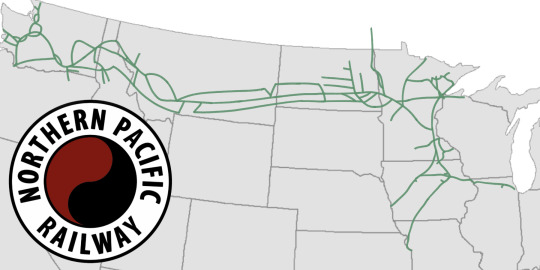
7. Northern Pacific — For this map, it shows how big the Northern Pacific Railway got after absorbing the Chicago Great Western and Duluth, Missabe and Iron Range railroads, as well as adding more mainlines to its network in the eighties.

8. Milwaukee Road — This map shows how big the Milwaukee Road got after the “Route of the Hiawatha” expanded its network by widening its existing mainlines and adding more mainlines (wherever possible) and expanding to northeastern Minnesota throughout the eighties.

9. Burlington Route — This map shows the Burlington Route after it absorbed the Kansas City Southern in the early 1960s and later expanded its network in the eighties.
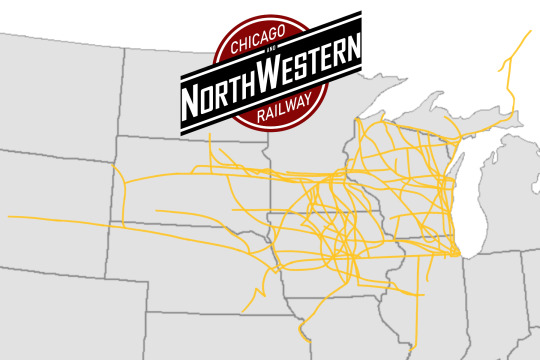
10. Chicago & NorthWestern — This map shows the size of Union Pacific’s ancient partner; the Chicago & NorthWestern, after it absorbed the Wisconsin Central and the Minneapolis and St. Louis railroads in the 60s plus expanding its network in the 80s.
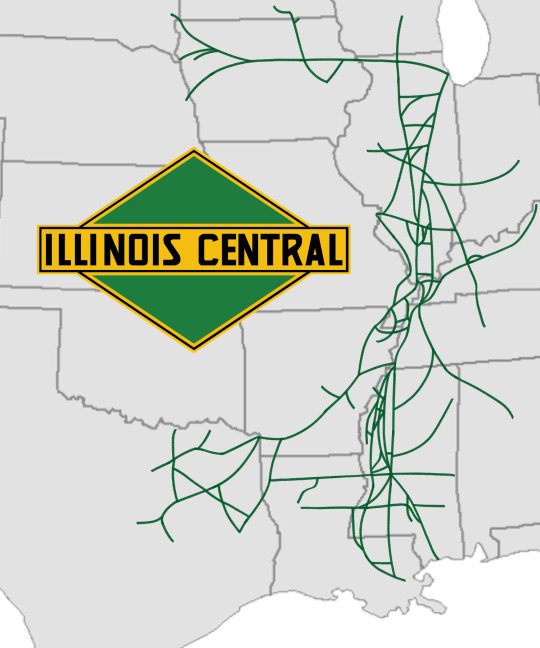
11. Illinois Central — This network map shows how big the Illinois Central got after acquiring the Cotton Bell Route in the 60s plus expanding its network in the 80s.
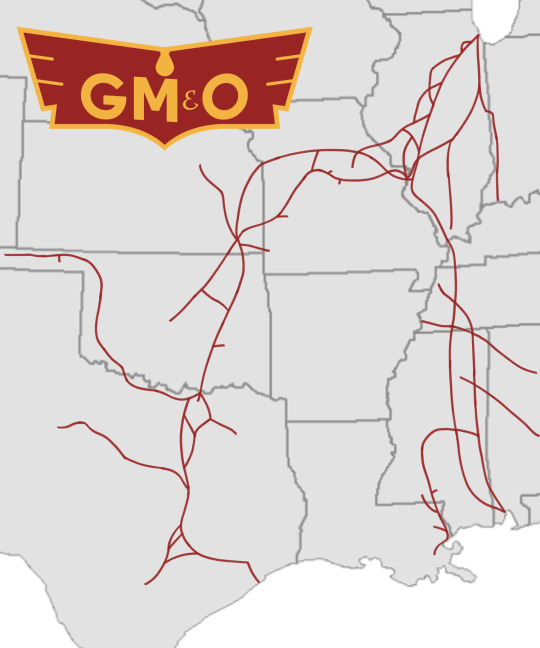
12. Gulf Mobile & Ohio — This map shows the size of the arch rival of the Illinois Central; the Gulf Mobile & Ohio, after it acquired the Chicago & Eastern Illinois and Missorui-Kansas-Texas railroads
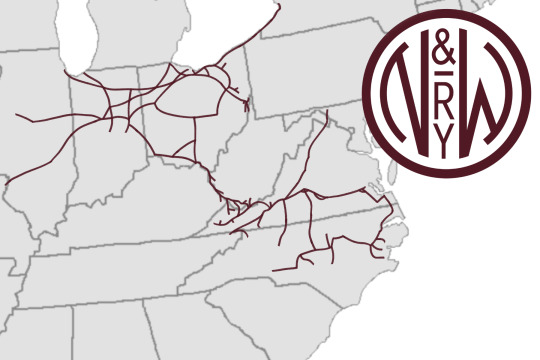
13. Norfolk & Western — Here, the map of the Norfolk & Western shows how big the N&W got after absorbing Nickel Plate Road and the (original) Norfolk Southern in throughout the 50s and 60s.
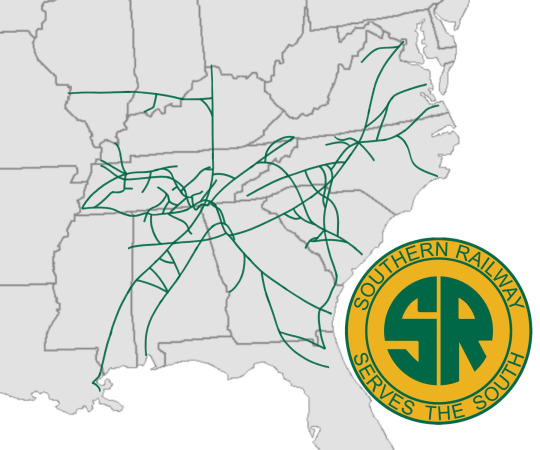
14. Southern Railway — This map of the Southern Railway shows how big the Southern got after absorbing Nashville, Chattanooga & St. Louis railroad and the central section of the Louisville & Nashville railroad in the 50s and 60s, as well as expanding its network in the 80s.

15. Seaboard Air Line — here, the Seaboard Air Line is shown how big it got after acquiring the Central of Georgia and West Point Route railroads plus the southern section of the Louisville & Nashville Railroad.
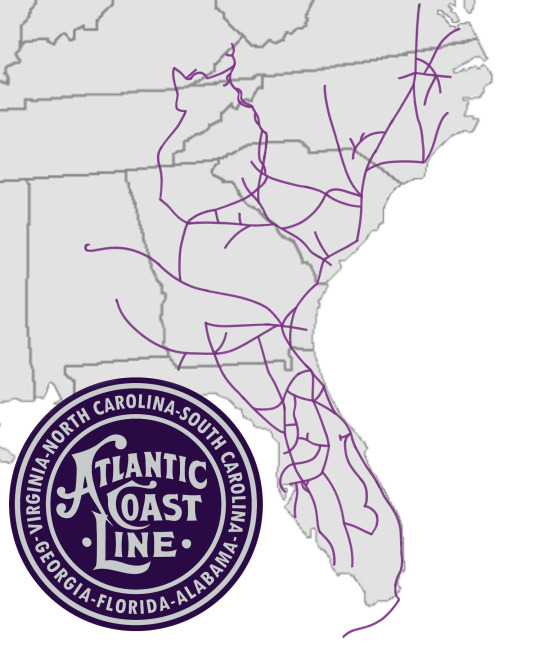
16. Atlantic Coast Line — This map shows how big Atlantic Coast Line absorbed Clinchfield Railroad, Oneida and Western and Florida East Coast railroads throughout the late 50s to late 60s.
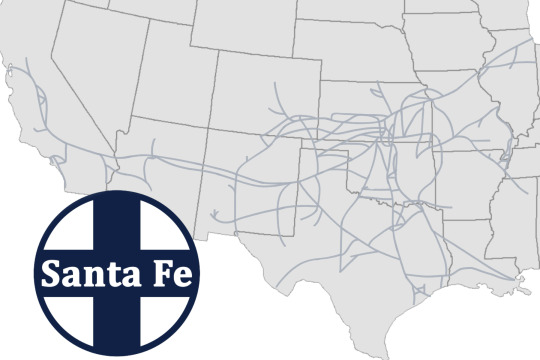
17. Santa Fe — This map shows the Santa Fe Railway after it absorbed half of the Frisco railroad in the early sixties and later expanded its network in the eighties.
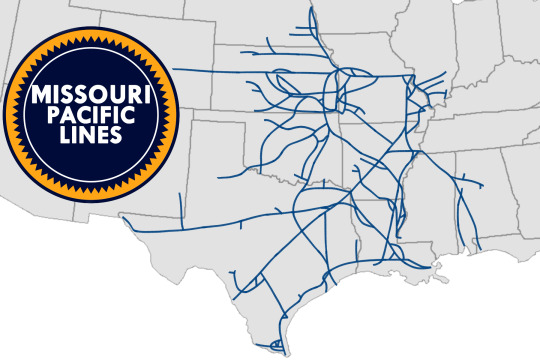
18. Missouri Pacific — This map shows the size of the Missouri Pacific after it absorbed the other half of the Frisco railroad and the Texas & Pacific Railroad in the early to late sixties.
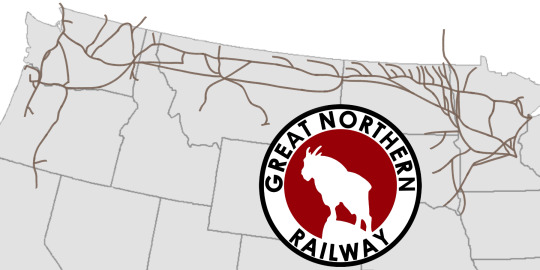
19. Great Northern — This map shows the size that Great northern Railway underwent after absorbing the Spokane Portland and Seattle Railway and adding more mainlines.
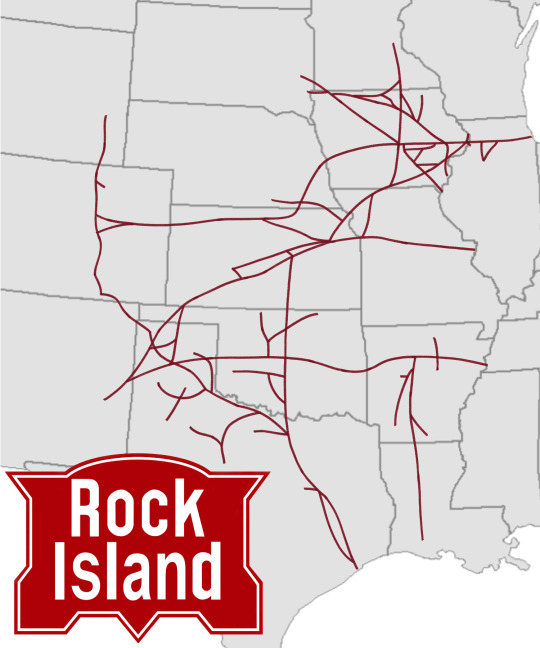
20. Rock Island — This map right here shows how big the Chicago Rock island and Pacific Railroad, or the Rock Island Railroad for short, has gotten after absorbing the Colorado and Southern Railroad and adding more mainlines and connecting to other mainlines order Rock Island ownership.
And with that, these maps show how big the railroads above have gotten. And since I’ve just returned to this topic, I’ll dig deeper into my thoughts and ideas about how things would go in this alternate timeline, which includes more posts talking about the history and posts talking about the locomotives and liveries on said locomotives, so stay tuned for all that.
8 notes
·
View notes
Video
Donner Pass Coal por John Benner Por Flickr: Southern Pacific SD45T-2 9207 in failed SPSF merger paint leads coal loads west climbing Donner Pass at MP 211 east of Truckee, CA along the Truckee River on the evening of May 23, 1987. This train had a 6-unit mid-train helper which can be seen here: www.flickr.com/photos/23375206@N05/49536109818/in/album-7... These trains of Utah coal were hauled into California for use in heating the air in rotary kilns at cement plants. I have no idea why I was using Kodachrome 200 here, as I hated the stuff with its golfball-sized grain. Perhaps I was still checking it out as it was only released 7 months previously. Thankfully the grain can be somewhat suppressed in the scan. Kodachrome PKL 200. Nikon FM2, Nikkor 180mm f/2.8 ED + TC200 for 360mm f/5.6.
18 notes
·
View notes
Photo

Day 2: EMD FP45
Info from Wikipedia
The EMD FP45 is a cowl unit type of C-C diesel locomotive produced in the United States by General Motors Electro-Motive Division (EMD). It was produced beginning in 1967 at the request of the Atchison, Topeka and Santa Fe Railway, which did not want its prestigious Super Chief/El Capitan and other passenger trains pulled by freight style hood unit locomotives, which have external walkways. The EMD SDP45 was a good passenger locomotive, but to the Santa Fe Railway it did not look the part. EMD therefore designed a lightweight "cowl" body to cover the locomotive, though it did not, as in earlier cab units, provide any structural strength, which remained in the frame. The cowl provided sleeker looks, better aerodynamics at speed, and allowed the crew to enter the engine compartment en route for diagnostics and maintenance. Final drive gear ratio for passenger service was 57:20. Santa Fe purchased nine of the locomotives (road numbers 100 through 108), and the Milwaukee Road bought five for its passenger service (road numbers 1 through 5). The Milwaukee Road units were delivered without Dynamic Braking. Reportedly, Illinois Central Railroad was considering an order for five FP45s as well (EMD order #5742, serial #s 34952-34956), but canceled it. Such low production was feasible and profitable for EMD since the locomotive was fundamentally just a re-clothed SDP45. Power, as in the SDP45, was from a V20 645E3 engine (or prime mover) developing 3,600 hp (2,680 kW). The locomotives were delivered painted in the Santa Fe's famous Warbonnet colors, in exactly the same style as the railroad's F units and GE U30CG. When Amtrak took over passenger service, the FP45s were reassigned to fast freight service, particularly Santa Fe's Super C high-speed intermodal run. Seven units were repainted from their original red and silver Warbonnet scheme to the standard blue and yellow freight scheme, while two units were painted into the blue and yellow warbonnet. Their steam generators were removed. Gearing was changed from 57:20 passenger gearing to 59:18 for freight service and they were permanently assigned to the freight pool. All Santa Fe FP45s except for #5995 were repainted in the Southern Pacific Santa Fe (SPSF) merger paint and then repainted in the blue and yellow warbonnet scheme after the merger denial. In June 1989, two of the units, #5992 and #5998, were repainted once more in a modified version of the Warbonnet scheme (this time, displaying Santa Fe in large, red letters "billboard"-style across the side, a livery previously worn by the GE U28CG) and re-designated as #101 and #102. The units reentered service on July 4 as part of the new "Super Fleet" — the first Santa Fe units to be so decorated for freight service. The six remaining units were thereafter similarly repainted and renumbered to 100-107. In 1990 with the purchase of the EMD GP60Ms the units were renumbered back in to the 5990s and were then renumbered again to 90-93 and 95-98 and remained in the Warbonnet scheme until their retirement in the late 1990s, after some 30 years of service. The units purchased by the Milwaukee Road were painted to the Milwaukee's orange and black scheme after Amtrak took over passenger service. A freight-only derivative, the EMD F45, was sold in greater numbers (86) to Santa Fe, the Great Northern Railway, and the Burlington Northern Railroad. Amtrak bought a similar passenger locomotive based on the 3,000 hp (2,240 kW) SD40-2, the SDP40F. The last three F45's in service were on the Montana Rail Link and the New York, Susquehanna and Western Railway in the northern and northeastern United States. These units were taken out of service in 2006 for the MRL and 2010 for the NYSW. Between April 1980 and December 1982, Santa Fe's San Bernardino shops rebuilt eight FP45s 5940-5943, 5945-5948. They emerged as 5990-5993, 5995-5998, and were redesignated SDFP45s. The 5944 was wreck retired in September 1981 on account of a wreck at Toland, Texas. Electrically they were upgraded to SD45-2 standards. Mechanically, they were re-geared from 59:18 to 60:17, reducing their top speed from 89 to 83 mph (143 to 134 km/h). In the mid 1980s Santa Fe again re-geared them - this time to 62:15 for 71 mph (114 km/h). Milwaukee Road's FP45s were all sold for scrap in 1981 and 1984. One of Santa Fe's SDFP45 No. 96 was wrecked in 1994 on Cajon Pass. While No. 91 was sold to the Wisconsin Central in January 1995, becoming their #6652 and the rest stayed in service right up until the BNSF merger in 1996, and were retired shortly after the merger.
Those that were not wrecked in service, or sold to other railroads, are on display in museums:
Santa Fe 90: was donated to the Oklahoma Railway Museum in Oklahoma City in a non-operational state. #90 was the last FP45 donated by the Santa Fe and had resided on a RIP track for two years before being delivered to the museum.
Santa Fe 92: was donated to the Illinois Railway Museum in Union, Illinois. In 2010, volunteers restored 92's control stand so that it could control other locomotives via MU. The locomotive was moved to National Railway Equipment in Silvis, IL during July 2017, where a replacement 20-645E3 engine, AR10 alternator, and a WBO air compressor (all purchased by the museum) were installed. This made the locomotive fully operational for the first time since at least 1997.
Santa Fe 93: preserved at the Great Plains Transportation Museum in Wichita, Kansas.
Santa Fe 95: preserved at the Western America Railroad Museum in Barstow, California.
Santa Fe 97: preserved at the Museum of the American Railroad in Frisco, Texas.
Santa Fe 108: was donated in operating condition minus the cab's air conditioner to the Southern California Railway Museum at Perris, California. This locomotive has the distinction of being the last passenger locomotive ever purchased by Santa Fe. Its restoration was completed in October, 2018 and it is now in operating condition for the first time since 2012.
Models and Route by: The Terminal, Auran, and Download Station
2 notes
·
View notes
